
by M. J. SALVATI
Last month we showed how to check some amplifier specs using just an audio generator, a.c. voltmeter, and a few homemade accessories. Most of the performance checks discussed this month require another item of test equipment, an oscilloscope. Before you start screaming, let me say that brand-new, dual-trace triggered-sweep 'scopes are available for below $600 (Soltec 515-2, Kikusui 5020, and Iwatsu 5702), and an old Heathkit or Eico recurrent–sweep 'scope can probably be obtained for around $100. If even that is too steep for your aching wallet, a device can be built for under $10 that will serve as an oscilloscope substitute in the following measurement procedures.
That device, shown in Fig. 1, is essentially a peak rectifier which serves as a clipping indicator in conjunction with an ordinary d.c. voltmeter. Its operating premise is that when clipping occurs, the peak voltage (as indicated on the d.c. voltmeter) will not increase further as the input signal to the amplifier is increased. The only drawback is that a few amplifiers don't clip cleanly, so their peak output voltages will increase a little even when they are clipping. Obviously, $10 won't buy you the world.
To use the clipping indicator, connect a d.c. voltmeter having a range of 0 to 5 V to the output of the clipping device. (If your voltmeter doesn't have this particular range, a range of 0 to 3 or 0 to 2.5 V will do.) Your next step is to connect the input terminals of the clipping device as directed whenever an oscilloscope is called for in the measurement procedures. Use the indicator's "Range" switch to keep the meter indication on scale; use the "Polarity" switch to check if clipping is non-symmetrical (i.e., clips in one direction before the other).
Maximum Output Power
This measurement procedure is not he one normally used for determining power output. Most power output measurements, including those mandated by the FTC and IHF, use the amplifier's rated distortion as the standard against which maximum power or voltage output is determined. Since good distortion analyzers are costly and specialized pieces of equipment, it is unlikely that many readers will have access to one. So, in keeping with the "simple equipment" premise of this series of articles, our maximum output measurements are limited to what the IHF calls "clipping power." In this measurement, the determinant for maxi mum output is the point at which clipping occurs. This is a fairly good method on modern transistorized amplifiers, since, according to Ed Foster, "today's amplifiers enter the clipping region very abruptly, and the difference in power capability as measured at some arbitrary percentage of distortion and that at clipping is negligible" ("New IHF Amp Standard," Audio, June 1978).
Equipment Needed. A signal generator, a.c. voltmeter, load resistors, and oscilloscope (or equivalent) are needed for maximum power output measurements. The signal generator and a.c. voltmeter must cover at least 20 Hz to 20 kHz. The voltmeter's accuracy should be no worse than 3% over this frequency range.
The load resistors must be capable of dissipating the full rated power output of the amplifier under test. This means large wire-wound resistors of better than 5% tolerance. You will need at least two 8-ohm resistors. If any of your power amplifiers are specified at 4 ohms, obtain four 8-ohm resistors.
These can be parallel-connected as 4 ohm pairs, or all four can be used singly for 4-channel amplifiers. Ideally, the load resistors should be non-inductive at all measurement frequencies.
Such resistors are available from Dale (NH250) and RCL (ALN-250) in the 250-watt size; these must be mounted on a large sheet of 1/8-inch-thick aluminum for heat-sinking (see Fig. 2). However, since these resistors are expensive and not stocked in retail stores, you will probably have to use whatever surplus bargains you can find. In all probability they will work satisfactorily, since low-resistance, high-power resistors are nowhere near as inductive as loudspeakers. Furthermore, the IHF now specifies a reactive load for some power measurements.

Fig. 1--This clipping indicator can be used, in conjunction with a d.c. voltmeter,
as an oscilloscope substitute in the measurements for maximum power output,
power bandwidth, damping factor, and preamp maximum output voltage.
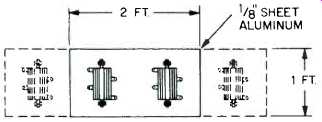
Fig. 2--High-power load bank for 2-channel amplifier. Dashed lines show extra
parts required for 4-channel or 4-ohm amplifiers.
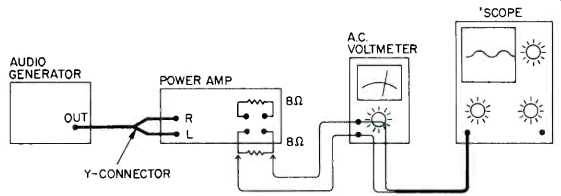
Fig. 3-Equipment setup for measuring maximum power output and power bandwidth.
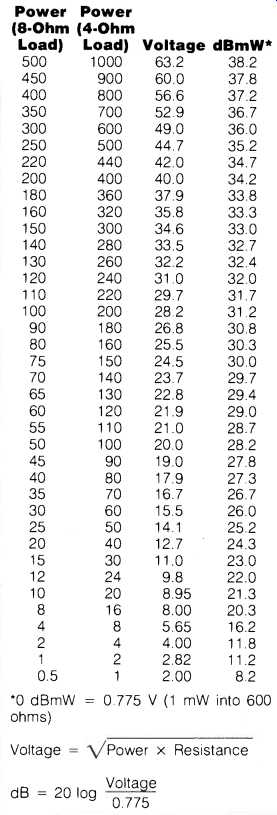
Table I--Power, voltage, and dBmW conversions.
Nearly any oscilloscope ever made will suffice for this procedure, as its only purpose is to indicate when clipping occurs. If you don't have access to a 'scope, build the clipping indicator described above, and use it whenever a 'scope is called for.
Basic Measurement Procedure. To measure maximum power output, proceed as follows:
1. Turn on all equipment (Fig. 3) and allow a few minutes warmup.
2. Set any filters, equalizers, and tone, boost or loudness controls on the amplifier to their flat-response positions. Set the amplifier's volume or gain control at minimum, and its balance control for equal outputs.
3. Set the generator frequency to 1 kHz. If measuring anything other than a separate power amplifier, set the generator output level to 0.5 V. If measuring a separate power amplifier, set its level control (if any) to maximum, and the generator output level to minimum.
4. Connect the generator output to a high-level input (AUX, tuner, or tape) of each channel. Both right and left channels of a stereo amplifier must be driven; all four channels of a 4-channel amplifier must be driven. Set the amplifier's mode or function switch to match the input selected.
5. Connect appropriate high-power load resistors to the speaker terminals of each channel. Connect the a.c. voltmeter and oscilloscope to the load resistors of the channel you wish to measure.
6. Set the a.c. voltmeter range switch to a range appropriate for the amplifier's rated power. (Use the data in Table I for power-to-voltage conversions.)
7. For power amplifiers, turn up the generator output-level control until the a.c. voltmeter indicates the voltage corresponding to about one-third of the rated power output (see Table I). For amplifiers other than separate power amplifiers, turn up the amplifier's gain or volume control for one-third rated power output. Let the amplifier operate at this level for 30 minutes.
8. For power amplifiers, turn up the generator output-level control until the sine wave displayed on the 'scope screen shows signs of clipping (on either or both peaks). For amplifiers other than separate power amplifiers, turn up the amplifier's gain or volume control until clipping occurs. Then, carefully reduce the signal level to just below the point where clipping occurs.
9. Record the voltage indicated on the a.c. voltmeter, both in volts and dB (sum of dB scale and range markings on the voltmeter). This is the maximum 1-kHz output voltage. The maximum power represented by this voltage can be determined from the conversion chart in Table I.
10. Reduce the signal level by around one-third, and change the audio generator frequency to 20 Hz.
11. Repeat Step 8.
12. Record the voltage indicated on the a.c. voltmeter.
13. Reduce the signal level by about one-third, and change the audio generator frequency to 20 kHz.
14. Repeat Step 8.
15. Record the voltage indicated on the a.c. voltmeter.
16. Take the lowest voltage reading recorded in Steps 9, 12, and 15, and convert it to power using Table I. This power level is the measured 20 Hz to 20 kHz power output of the amplifier for the channel measured.
17. Repeat Steps 8 to 16 for each of the other channels.
Power Bandwidth. After setting up the equipment and measuring 1-kHz output voltage and power as described under Basic Measurement Procedure, proceed as follows:
1. Reduce the amplifier output level to 3 dB less than the voltage recorded in Step 9 of the preceding procedure. For example, if the Step 9 voltage recorded was 26.8 V (+ 30.8 dBmW), then reduce the level to 19 V (+27.8 dBmW).
2. Change the audio generator frequency to about 100 Hz, then slowly lower the frequency until signs of clipping appear on the oscilloscope. Record the lowest frequency at which non-clipped power output is obtainable at the-3 dB level. Make certain the amplifier output is maintained at the Step 1 level.
3. Change the audio generator frequency to about 10 kHz, then slowly increase the frequency until signs of clipping appear on the 'scope. Record the lowest frequency at which non clipped power output is obtainable at the-3 dB level. Make certain the amplifier output is maintained at the Step 1 level.
4. The frequencies recorded in Steps 2 and 3 represent the measured-3 dB power bandwidth of the amplifier under test.
Damping Factor
Damping factor is the measure of an amplifier's output voltage regulation, and an indirect measure of its output impedance. The higher the damping factor, the better the regulation and the lower the output impedance.
Equipment Needed. An audio generator, a.c. voltmeter, and load resistors are all the items necessary for this procedure. However, an oscilloscope is also recommended.
The audio generator and a.c. voltmeter need operate at only 50 Hz to 1 kHz. However, wide-band damping factor is measured over a range from 20 Hz to 20 kHz, requiring a generator and voltmeter capable of operating over this range. In either case, the a.c. voltmeter must have extremely high resolution. This rules out the ordinary analog a.c. voltmeter. Instead, a digital voltmeter must be used, preferably one that displays a minimum of four digits at all times. This means either a 4 1/2-digit DVM, or a 31/2-digit DVM used with power-scaling resistors (see Fig. 4). As the Table accompanying Fig. 4 shows, these resistors change an output voltage to the 10 to 20 V range, where a 3 1/2-digit DVM displays four digits. Note, however, that this device can only improve the resolution of a low-cost instrument. If the DVM has a very limited frequency response (characteristic of low-cost DVMs), it cannot be used for measuring wide-band damping factor.
The load resistors must dissipate the full rated output power of the amplifier under test, so a high-power load bank like that used for the maximum output power measurement is needed here.
An oscilloscope (nearly any kind will do) is recommended to make sure that the amplifier under test is not clipping when driven to full rated output during the measurement. But if you know the amplifier is capable (from prior tests) of delivering its rated output, forget about the 'scope.

Fig. 4--Power scaler for 3 1/2-digit DVM. Select value for 1% resistor R from
accompanying Table.
Basic Measurement Procedure. To measure damping factor, proceed as follows:
1. Turn on all equipment and allow an appropriate warmup time, about 5 minutes for semiconductor equipment and 15 minutes for vacuum-tube equipment.
2. Set any filters, equalizers, and tone, boost or loudness controls on the amplifier to their flat-response positions. Set the amplifier's volume or gain control to minimum, and its balance control for equal outputs.
3. Set the audio generator frequency to 1 kHz (old equipment) or 50 Hz (new equipment). If measuring anything other than a separate power amplifier, set the generator output level to 0.5 V. If measuring a separate power amplifier, set its level control (if any) to maximum, and the generator output level to minimum.
4. Connect the audio generator output to a high-level input (AUX, tuner, or tape) of each channel. Both right and left channels of a stereo amplifier must be driven; all four channels of a 4-channel amplifier must be driven. Set the amplifier's function selector to match the input selected.
5. Connect high-power load resistors to the speaker terminals of each channel. This connection, and that to the a.c. voltmeter, must be done in a special way to make a valid measurement. Do not connect the voltmeter across the load resistors. Do not connect the voltmeter anywhere on the wires connecting the speaker terminals to the load. Connect the DVM to the excess wire protruding past the speaker terminals, as shown in Fig. 5.
Clean the portion of the wire under the post, and make sure the post is tightened.
6. Set the DVM range switch to a range appropriate for the amplifier's rated power output. If using a 3 1/2-digit DVM, set its range switch to 20 V, and select the appropriate scaling resistors (see Table in Fig. 4).
7. For power amplifiers, turn up the audio generator's output-level control until the DVM indicates the voltage corresponding to the amplifier's rated power output (see Table I). For integrated amplifiers and receivers, turn up the amplifier's gain or volume control. Record the indicated voltage to four decimal places.
8. Disconnect one of the leads going to the load from the channel you are measuring. Measure the no-load voltage to four places and record it.
9. From the full-load and no-load voltages measured in Steps 7 and 8 respectively, you can determine the damping factor, percent regulation, and output impedance of the amplifier.
The formulas are as follows:
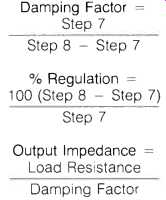
Wide-band Damping Factor. Wide band damping factor is the minimum damping factor measured at a number of frequencies over the rated bandwidth of the amplifier. This generally means making damping factor measurements (per the Basic Measurement Procedure) at a number of different frequencies between 20 Hz and 20 kHz, unless the manufacturer claims a different bandwidth for rated power output.
If you measure wide-band damping factor, check the instruction manual of your DVM to make certain it is usable in the 20 Hz to 20 kHz range. Many low-priced DVMs do not function well (or at all) past 1 kHz.
Maximum Input and Output Voltage of Preamps
For the same reasons cited in the previous measurement procedure, this is not the method normally used to determine maximum output voltage. In this procedure, the onset of clipping is used instead of a specified distortion level as the criterion for maximum output.
Equipment Needed. A signal generator, a.c. voltmeter, load resistors, and oscilloscope (or equivalent) are needed for maximum output-voltage measurements. The signal generator and a.c. voltmeter should cover 10 Hz to 100 kHz as a minimum. The voltmeter accuracy should be no worse than 3% over this frequency range.
The load resistors are the same as those used for S/N ratio and frequency response measurements, discussed in last month's issue: 10-kilohm, 5%, 1/4 watt carbon-film resistors paralleled by 1,000-pF capacitance.
Nearly any oscilloscope will suffice for this procedure. If you don't have access to a 'scope, use the clipping indicator described at the beginning of this article for the Basic Measurement Procedure.
A step attenuator having 20- and 40-dB outputs is needed for the phono overload voltage measurement procedure. The homemade one described in last month's article is ideal.
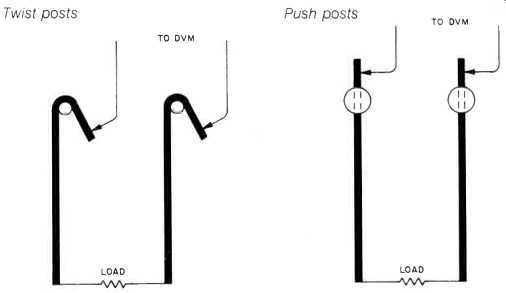
Fig. 5--Connection techniques for damping-factor measurement. Note that DVM
is not connected between the amplifier and load resistor.

Fig. 6--Equipment setup for measuring preamp maximum input and output voltages.
Note that step attenuator shown here is only for phono overload voltage measurement.
Basic Measurement Procedure. To measure maximum output voltage, proceed as follows:
1. Turn on all equipment (Fig. 6) and allow an appropriate warmup time, about 5 minutes for semiconductor equipment and 15 minutes for vacuum-tube equipment.
2. Set any filters, equalizers, and tone, boost or loudness controls on the amplifier to their flat-response positions. Set the amplifier's volume or gain control to maximum, and its balance control for equal outputs.
3. Set the audio generator frequency to 20 Hz, and its output level at minimum.
4. Connect the generator output to a high-level input (AUX, tuner, or tape) of one of the channels. Set the amplifier's mode or function switch to match the input selected.
5. Connect the a.c. voltmeter and oscilloscope (or equivalent) to the output jack of the measurement channel.
Connect the load across the a.c. voltmeter input terminals.
6. Set the a.c. voltmeter range switch one range higher than is appropriate for the amplifier's rated output voltage.
7. Turn up the audio generator's output level until clipping occurs on either peak, as displayed on the oscilloscope. Note: Clipping is often not symmetrical in voltage amplifiers, so if you are using the clipping indicator instead of a 'scope, do this step twice (once for each position of the polarity switch) and look for the lowest output voltage at which clipping occurs.
8. Readjust the a.c. voltmeter range switch (if necessary) for an on scale indication. Record the voltage indicated.
9. Disconnect the a.c. voltmeter from the preamp's output terminals, and reconnect it to the audio generator output. Note: If your generator has low output impedance, there is no need to disconnect the 10-kilohm load from the voltmeter input terminals.
10. Measure and record the generator output voltage (preamp input voltage) with the a.c. voltmeter.
11. Repeat Steps 3 to 10 at 1 kHz and 20 kHz. The lowest Step 8 voltage recorded is the measured 20 Hz to 20 kHz maximum output voltage for that channel. The lowest Step 10 voltage recorded is the measured 20 Hz to 20 kHz maximum high-level input-signal voltage for that channel at full gain.
12. Repeat Steps 3 to 11 for the other channel.
Phono Overload Voltage. In the phono mode, considerable amplification takes place before the amplifier's volume or gain control, so it is important to know how much input voltage can be applied before the phono preamp overloads. Because of the equalization involved in the phono circuitry, measurements are made at 1 kHz only.
Note: This variation of maximum input voltage also applies to receivers and integrated amplifiers.
1. Turn on all equipment (Fig. 6) and allow an appropriate warmup time, about 5 minutes for semiconductor equipment and 15 minutes for vacuum-tube equipment.
2. Set any filters, equalizers, and tone, boost or loudness controls on the amplifier to their flat-response positions. Set the amplifier's volume or gain control to minimum, and its balance control for equal outputs.
3. Set the generator frequency to 1 kHz, and its output level to 0.5 V.
4. Connect the generator's output to the attenuator input. Connect the appropriate attenuator output jack to the phono input you wish to measure.
Use the -20 dB output for a high-level (MM) phono input; use the-40 dB output for a low-level (MC) phono input.
5. Connect the oscilloscope to the output jack of the measurement channel. Connect the load across the 'scope terminals. Note: A 'scope is mandatory; the substitute clipping indicator is not usable in this procedure.
6. Connect the a.c. voltmeter across the attenuator output. Use a Tor Y-connector to feed the attenuator output to both the a.c. voltmeter and the phono input. Set the voltmeter range switch to 1 V.
7. Turn up the amplifier's volume or gain control until clipping occurs on either peak, as observed on the 'scope. At this point clipping is due to limiting in the amplifier output stage.
8. Reduce the volume or gain control setting until clipping disappears, then increase the generator output level until clipping reappears. Continue doing this until reducing the volume or gain control setting no longer prevents clipping.
9. When you have precisely determined the lowest generator output level at which clipping occurs regardless of the amplifier's volume control setting, adjust the a.c. voltmeter's range switch for maximum on-scale deflection, and record the voltage in millivolts. This is the phono input overload voltage.
10. Repeat Steps 3 to 9 for the other channel.

Fig. 7--Equipment setup for measuring crosstalk and separation (shown for
integrated amplifier or receiver).
Crosstalk and Separation
Crosstalk is the leakage of an unselected signal source into the signal chain (e.g., tuner signal leakage when the function selector is set to phono). Separation is the leakage of one channel's signal into the other channel.
These specifications are only occasionally given in manufacturers' specifications for amplifiers, so I've saved this test procedure for the end of the series. Still, crosstalk symptoms are a common occurrence in complex audio systems, so these procedures are very useful in isolating their cause.
Equipment Needed. Crosstalk and separation measurements require an audio generator and a.c. voltmeter operable at 1 kHz, load resistors, and input terminations. For measurements involving phono inputs, an attenuator is also required.
The a.c. voltmeter must be equipped with dB scales if you wish to avoid excessive calculations and dB conversions. Ideally, its most sensitive range should be -80 dB (100 µV, full scale). Since voltmeters of this type are expensive, a -40 dB (10 mV, full scale) voltmeter preceded by a 40-dB amplifier is a good substitute. The filter/amp described in last month's article is highly suitable for this purpose.
The input terminations are 1 kilohm for most inputs, and 100 ohms for MC phono inputs. You can make these yourself, as described last month.
The load resistors needed are a pair of 16-ohm, 5%, 1-watt carbon resistors, connected in parallel, for each power-amplifier output, and a 10-kilohm, 5%, 1/4-watt carbon resistor paralleled by 1,000-pF capacitance for each preamp output. However, if you use the filter/amp as a voltmeter preamplifier, its own input impedance will serve as a suitable load for preamp outputs.
A 40- or 60-dB attenuator (such as the homemade one described in Part I) is needed only if a phono input is driven.
Crosstalk Measurement Procedure. To measure crosstalk between inputs of the same channel, proceed as follows:
1. Turn on all equipment (Fig. 7) and allow an appropriate warmup time, about 5 minutes for semiconductor equipment and about 15 minutes for vacuum-tube equipment.
2. Set any filters, equalizers, and tone, boost or loudness controls on the amplifier to their flat-response positions. Set the amplifier's volume or gain control to minimum, and its balance control for equal outputs.
3. Connect the audio generator output to the attenuator input, and the appropriate attenuator output jack to one of the amplifier's input jacks. Use the 0-dB output (or no attenuator at all) if driving the AUX, tuner, tape, etc. inputs, the -40 dB output for high-level (MM) phono, and the-60 dB output for low-level (MC) phono.
4. Insert input terminations in the undriven inputs of the channel being measured. Use 1-kilohm terminations for AUX, tuner, tape and MM phono, and 100-ohm for MC phono inputs.
5. Set the generator frequency to 1 kHz, and its output level to 0.5 V.
6. Connect the appropriate loads across the amplifier output terminals.
Use 8 ohms, 2 watts (minimum) for receivers and power amplifiers, and 10 kilohms for preamps. Connect the a.c. voltmeter input terminals across the load resistor of the channel being measured.
7. Set the a.c. voltmeter range switch to 0 dB for preamps, or + 10 dBmW for receivers.
8. Set the amplifier's function or mode selector to match the driven input. Then, adjust the amplifier's volume or gain control for a 0-dB indication on the a.c. voltmeter. Use 2.45 V (+10 dBmW) for receivers and 0.775 V (0 dBmW) for preamps.
9. Set the amplifier's function or mode selector to one of the terminated inputs.
10. Down-range the a.c. voltmeter until you get a usable indication. If necessary, add additional amplification between the amplifier output and a.c. voltmeter. (If you use the filter/amp described in last month's article, select C-weighting.)
11. Record the a.c. voltmeter indication in dB. The crosstalk between the driven and the selected terminated inputs is the difference between the reference level and the sum of three dB figures: The meter range, the meter scale, and the filter/amp gain (if used). For our calculations, use the plus or minus signs of the meter scale and meter range switch as marked, and consider the filter/amp gain as negative. For example, if we were measuring crosstalk between two preamp inputs (0-dBmW reference), the meter scale might indicate-6.5 dB when the meter range switch is set to its 20 dB position and 40-dB extra amplification is used. We then simply add these figures like so:
-6.5-20-40 = -66.5 dB crosstalk.
However, if we were measuring a receiver or integrated amplifier, the extra 10-dB for the Step 8 reference level must also be algebraically subtracted.
Assuming the same numbers, the crosstalk is:
-6.5-20-40-(+10) = -76.5 dB crosstalk.
12. In turn, reset the amplifier's function or mode switch to each of the other terminated inputs, and repeat Step 11.
13. Repeat Steps 3 to 12 for the other channel.
Separation Measurement Procedure. Channel-to-channel separation can be performed on power amplifiers as well as on preamps, receivers, integrated amplifiers, and equalizers. This measurement procedure is very similar to Steps 1 to 11 of the Crosstalk Measurement Procedure. The exceptions are as follows: In Step 4, terminate the corresponding input of the undriven channel. In Step 9, do not disturb the amplifier's function or mode selector setting. Instead, switch the a.c. voltmeter to the load resistor of the undriven channel.
I hope that these relatively inexpensive methods of checking the basic performance parameters of your stereo system will prove of value. Bear in mind that these approaches will not yield measurements of utmost accuracy. However, being able to make the tests at all, without the investment of thousands of dollars, is certainly worth consideration.
Also see: Part 1
(adapted from Audio magazine, Mar. 1984)
= = = =